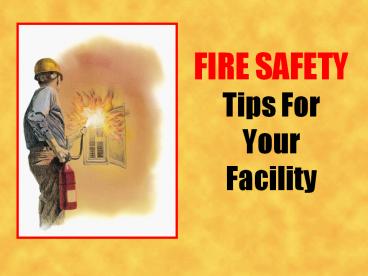FIRE%20SAFETY%20Tips%20For%20Your%20Facility - PowerPoint PPT Presentation
Title:
FIRE%20SAFETY%20Tips%20For%20Your%20Facility
Description:
Fire Extinguishers. The faceplate of every fire extinguisher shows the class or classes of fire it ... A Aim the extinguisher's hose or nozzle at the bottom of ... – PowerPoint PPT presentation
Number of Views:593
Avg rating:3.0/5.0
Title: FIRE%20SAFETY%20Tips%20For%20Your%20Facility
1
FIRE SAFETY Tips For Your Facility
2
Assignment
- Read Brauer Chapter 16
3
Elements Of FireFire is a chemical reaction
involving rapid oxidation or burning of a fuel.
It needs four elements to occur Fuel
Oxygen Heat Chemical reaction.
- Take away any one of these factors, and the fire
cannot exist!
October Is National Fire Prevention Month
4
Fire Problem in US Annually
- 1 million fires involving structures
- 8000 deaths
- gt20,000,000,000 total property loss
- These figures do not include indirect costs
- Litigation, investigation, etc.
5
Leading Causes of Industrial Fires
- Electrical (23)
- Smoking materials (18)
- Friction (10)
- Overheated materials (8)
- Hot surfaces (7)
- Burner flames (7)
- Others (27) Sparks, Spontaneous ignition,
Cutting, Welding, Arson, Chemical action,
Lightning, Molten substances
6
Fire Related Deaths
- 25 of fire-related deaths are from burns
- 2/3rds are from inhalation of CO, smoke, toxic
gases, asphyxiation - 10 are from mechanical injuries, relating to
falls or falling materials - Overall death rate is 2.8 per 100,000 population
- lt5 yrs old higher than average
- 75-85 ages 12.5 gt85 years 22.2
- Deaths are often alcohol related (perhaps gt80)
- Most fatal fires involve 1 or 2 victims
- Large losses receive most publicity
7
Infamous Fireshttp//www.olafire.com/OtherFires.a
sp
- 12/30/1903 602 Chicagos Iroquois Theater
- 3/25/1911 145 - Triangle Shirtwaist Factory, NYC
- 11/28/1942 492 Cocoanut Grove nightclub,
Boston - 7/6/1944 168 Ringling Brothers and Barnum
Bailey Circus, Hartford, CT - 12/1/1958 95 - Our Lady of Angels Grade School,
Chicago - 5/28/1977 165 Beverly Hills Supper Club,
Southgate, KY - 11/21/1980 85 - MGM Grand Hotel, Las Vegas
- 12/4/1980 26 Stouffer Inn, NYC
- 9/3/1991 25 Imperial Foods, Hamlet, NC
- 9/11/2001 2752 - World Trade Center
- 2/20/2003 100 Great White concert at The
Station nightclub, West Warwick, RI
8
Classes Of FireFires are classified according to
the types of objects being burnedClass A
ordinary combustibles such as wood, paper, cloth,
rubber or certain types of plasticClass B
flammable or combustible gases and liquids such
as gasoline, kerosene, paint, paint thinners or
propaneClass C energized electrical equipment
such as appliances, switches or power
toolsClass D certain combustible metals such
as magnesium, titanium, potassium or sodium.
9
Fire ExtinguishersThe faceplate of every fire
extinguisher shows the class or classes of fire
it is designed to fight.To properly use a fire
extinguisher, follow the P-A-S-S procedure
P Pull the pin A Aim the extinguishers hose or
nozzle at the bottom of the fire S Squeeze the
trigger S Sweep it slowly back and forth,
covering the entire fire with the extinguishing
substance.
P
A
S
S
October Is National Fire Prevention Month
10
Methods of Controlling Extinguishing Fire
- Remember the fire pyramid
- Cool the fire
- Limit the oxygen supply
- Remove the fuel
- Inhibit the reaction producing hydroxyl (OH)
radicals
11
Products of Combustion
- Varies widely
- Flames, heat, smoke (fine solid particles), gases
(carbon monoxide, carbon dioxide, hydrogen
sulfide, sulfur dioxide, ammonia, hydrogen
cyanide, hydrogen chloride, nitrogen dioxide,
acrolein, phosgene) - CO can cause death in lt1 min with gt1
concentration - Lack of O2 (normal is 20.9)
12
What To Do If Fire OccursPrepare yourself in
advance! Take a moment to review your companys
written Emergency Action Plan. It should include
How to notify the fire department
Detailed evacuation plans Designated employees
in charge of evacuation.
October Is National Fire Prevention Month
13
Hot Work
- Operations such as welding, brazing, soldering,
cutting, chipping, grinding, drilling Use of
spark-producing power tools Heat guns - Flammable, combustible, or ignitable materials
should be kept gt 20 feet away or covered with
flame-retardant material
14
Flammable Combustible Liquids
- OSHA definition
- Flammable
- Liquid that has a flash point lt 100ºF
- Combustible
- Liquid that has a flash point between 100ºF and
200ºF - Ignitable solids that can burn when sufficient
heat is applied
15
Hot Work Program
- Companies that have flammable, combustible, or
ignitable materials and need to perform hot work
in or around these materials need to have a Hot
Work Program - Written Program
- Pre-work inspection
- Signed permit to show inspection and approval
16
Fire Safety Objectives
- Getting occupants out safely
- Minimizing property loss for structures and
contents - Minimizing interruption of operations
17
Fire Safety Fundamentals
- Site Planning Accessibility
- Separation of Structures
- Building Construction Materials
- Fire Resistance Ratings
- See Brauer Table 16-4
- Confinement / Compartmentation
- Consider Fire Load and Fire Spread
18
Industrial Process Fire Hazard
- Venting
- Fire Walls
- Welding Cutting
- Hot Work Permits
- Indoor Storage of Flammable Liquids
- Warehouses
19
Life Safety
- Protection of human life is 1 priority
- Understanding human behavior in fires
- General Principles of Life Safety
- 3 classes of hazard low, ordinary, high
- Type of occupancy residential, assembly,
hospitals, industrial
20
General Principles of Life Safety
- Interior Finishes
- Means of Egress
- Capacity
- Number of Means of Egress
- Exit Access
- Width
- Stairs































